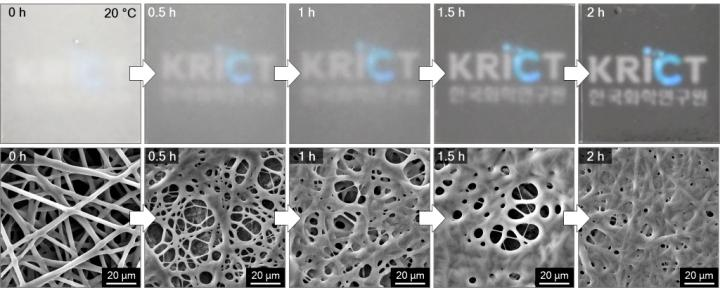Apr 7 2020
People cannot differentiate with their naked eye whether the cold-chain food products received by them have actually become spoiled.
 The change of the readability of the sticker attached with nanofiber film after being exposed to room temperature. Image Credit: Korea Research Institute of Chemical Technology (KRICT).
The change of the readability of the sticker attached with nanofiber film after being exposed to room temperature. Image Credit: Korea Research Institute of Chemical Technology (KRICT).
In this regard, a cold-chain safety sticker was created that indicates whether any cold-chain food products such as fruits, vegetables, meat, or fish, have gone bad.
Upon exposure to room temperature (10 °C or higher), this cold-chain safety sticker produces an image on it. History and the time of room-temperature exposure across the cold chain delivery process are denoted but cannot be corrected manually.
On the whole, when frozen or refrigerated foods are subjected to room temperature, microorganisms start to grow and reproduce. But it is not easy to find out whether the foods have actually become spoiled with the naked eye. The reason is that some of the microorganisms do not impact the smell and taste of foods where they dwell, and the frozen foods virtually have the same appearance even after the refreezing and melting cycles.
In such a situation, the cold-chain safety sticker will be able to inhibit the occurrence of hamburger disease, food poisoning, etc. in advance, which can possibly occur when spoiled foods caused by the malfunction of freezer or refrigerator trucks are consumed unknowingly.
In addition, this cold-chain safety sticker is flexible and thin, and its production cost is also low. Such a technology is anticipated to have high potential for applications in the rapidly increasing fresh food delivery market.
A team of researchers from the Research Center for Bio-based Chemistry of the Korea Research Institute of Chemical Technology (KRICT, Dr Dongyeop Oh, Dr Sung Yeon Hwang, Dr Jeyoung Park, and Dr Sejin Choi) has now devised a novel technology and has published the related results in the prominent journal, Advanced Materials, online.
A nanofiber film represents the core technology of the cold-chain safety sticker. To develop this sticker, the scientists tried to fix a regular film on the rear side of this recently developed nanofiber film. During low temperatures, the nanofiber film exhibits a steady structure in which thin threads cross one another and hence seems to be opaque due to the scattering of light.
But when this nanofiber structure is subjected to room temperature for a specific duration of time, it breaks down. More specifically, these thin threads begin to melt and become entwined with one another. This enables the light to pass via the nanofiber film, thus making it seem to be transparent.
On the basis of this mechanism, the image created on the back of the standard film becomes visible from the front, when the nanofiber film—fixed to the front surface of the sticker—becomes transparent upon exposure to room temperature. This change enables users to find out whether their food products have gone bad.
The scientists have also identified a method to manage the time needed for this nanofiber film to become transparent upon exposure to room temperature. This was experimented based on the fact that the time required before the spoilage occurs in each food would differ.
Hence, every sticker was made to become transparent following a minimum of 30 minutes to a maximum of 24 hours of room-temperature exposure. This technique works in the same manner as a timer does. The method was achieved by regulating the thickness and composition of the used nanofiber.
This sticker, once exposed to room temperature, cannot be restored to its original state even if one attempts to refrigerate or freeze it again. Also, room-temperature exposure time cannot be manually adjusted. This means that there is virtually no room for any manipulation.
Dr Dongyeop Oh, Research Center for Bio-based Chemistry Korea Research Institute of Chemical Technology
The new cold-chain safety sticker can extensively be utilized for food product applications and also for the cold-chain distribution of costly drugs and medical supplies. This can be attributed to the thin and flexible design of the sticker, wherein the estimated manufacturing cost of this sticker is only 1 cent each.
At present, a kit that indicates the history of room-temperature exposure has become one of the competing goods. This kit was designed by chemical companies in the world to apply the cold-chain distribution of costly drugs and medical supplies.
Using chemical reactions of special-purpose inks, the kit indicates whether it has been subjected to room temperature. On the other hand, it is made of thick plastic, which makes it quite difficult to fix it to numerous objects, and its production costs involve several thousand won.
Those existing kits used for the distribution of medicine and medical supplies involve a risk that the special ink contained in them may leak if they are damaged. In contrast, the developed cold-chain safety sticker is free from any risk of chemical leakage even if it is damaged during delivery. It will still function properly even after such damage.
Dr Sejin Choi, Research Center for Bio-based Chemistry Korea Research Institute of Chemical Technology
All these research achievements were published in the prestigious journal, Advanced Materials online, on February 5th, 2020 under the title “A Self-Healing Nanofiber-Based Self-Responsive Time-Temperature Indicator for Securing a Cold-Supply Chain.”
Such accomplishments were realized as part of the major projects of the Ministry of Science and ICT and KRICT.